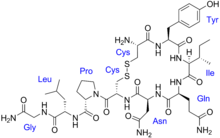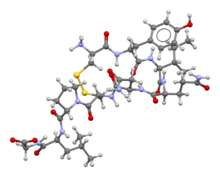
Back أكسيتوسين Arabic Oksitosin Azerbaijani اوکسیتوسین AZB Аксітацын Byelorussian Аксытацын BE-X-OLD Окситоцин Bulgarian অক্সিটোসিন Bengali/Bangla Oksitocin BS Oxitocina Catalan Oxytocin Czech
 | |
 | |
| Clinical data | |
|---|---|
| Pronunciation | /ˌɒksɪˈtoʊsɪn/ |
| ATC code | |
| Physiological data | |
| Source tissues | Pituitary gland |
| Target tissues | Wide spread |
| Receptors | Oxytocin receptor |
| Antagonists | Atosiban |
| Precursor | Oxytocin/neurophysin I prepropeptide |
| Metabolism | Liver and other oxytocinases |
| Legal status | |
| Legal status | |
| Pharmacokinetic data | |
| Protein binding | 30% |
| Metabolism | Liver and other oxytocinases |
| Elimination half-life | 1–6 min (IV) ~2 h (intranasal)[2][3] |
| Excretion | Biliary and kidney |
| Identifiers | |
| |
| CAS Number | |
| PubChem CID | |
| IUPHAR/BPS | |
| DrugBank | |
| ChemSpider | |
| UNII | |
| KEGG | |
| ChEBI | |
| ChEMBL | |
| CompTox Dashboard (EPA) | |
| ECHA InfoCard | 100.000.045 |
| Chemical and physical data | |
| Formula | C43H66N12O12S2 |
| Molar mass | 1007.19 g·mol−1 |
| 3D model (JSmol) | |
| |
| |
| (verify) | |
Oxytocin is a peptide hormone and neuropeptide normally produced in the hypothalamus and released by the posterior pituitary.[4] Present in animals since early stages of evolution, in humans it plays roles in behavior that include social bonding, love, reproduction, childbirth, and the period after childbirth.[5][6][7][8] Oxytocin is released into the bloodstream as a hormone in response to sexual activity and during childbirth.[9][10] It is also available in pharmaceutical form. In either form, oxytocin stimulates uterine contractions to speed up the process of childbirth. In its natural form, it also plays a role in maternal bonding and milk production.[10][11] Production and secretion of oxytocin is controlled by a positive feedback mechanism, where its initial release stimulates production and release of further oxytocin. For example, when oxytocin is released during a contraction of the uterus at the start of childbirth, this stimulates production and release of more oxytocin and an increase in the intensity and frequency of contractions. This process compounds in intensity and frequency and continues until the triggering activity ceases. A similar process takes place during lactation and during sexual activity.
Oxytocin is derived by enzymatic splitting from the peptide precursor encoded by the human OXT gene. The deduced structure of the active nonapeptide is:
- ^ "FDA-sourced list of all drugs with black box warnings (Use Download Full Results and View Query links.)". nctr-crs.fda.gov. FDA. Retrieved 22 Oct 2023.
- ^ Weisman O, Zagoory-Sharon O, Feldman R (September 2012). "Intranasal oxytocin administration is reflected in human saliva". Psychoneuroendocrinology. 37 (9): 1582–1586. doi:10.1016/j.psyneuen.2012.02.014. PMID 22436536. S2CID 25253083.
- ^ Huffmeijer R, Alink LR, Tops M, Grewen KM, Light KC, Bakermans-Kranenburg MJ, et al. (2012). "Salivary levels of oxytocin remain elevated for more than two hours after intranasal oxytocin administration". Neuro Endocrinology Letters. 33 (1): 21–25. PMID 22467107.
- ^ Gray's Anatomy: The Anatomical Basis of Clinical Practice (41 ed.). Elsevier Health Sciences. 2015. p. 358. ISBN 978-0-7020-6851-5.
- ^ Audunsdottir K, Quintana DS (2022-01-25). "Oxytocin's dynamic role across the lifespan". Aging Brain. 2: 100028. doi:10.1016/j.nbas.2021.100028. ISSN 2589-9589. PMC 9997153. PMID 36908876. S2CID 246314607.
- ^ Leng G, Leng RI (November 2021). "Oxytocin: A citation network analysis of 10 000 papers". Journal of Neuroendocrinology. 33 (11): e13014. doi:10.1111/jne.13014. hdl:20.500.11820/d2bdf31e-1d12-4abf-80a3-659a7e31a9f7. PMID 34328668. S2CID 236516186.
- ^ Francis DD, Young LJ, Meaney MJ, Insel TR (May 2002). "Naturally occurring differences in maternal care are associated with the expression of oxytocin and vasopressin (V1a) receptors: gender differences". Journal of Neuroendocrinology. 14 (5): 349–53. doi:10.1046/j.0007-1331.2002.00776.x. PMID 12000539. S2CID 16005801.
- ^ Gainer H, Fields RL, House SB (October 2001). "Vasopressin gene expression: experimental models and strategies". Experimental Neurology. 171 (2): 190–9. doi:10.1006/exnr.2001.7769. PMID 11573971. S2CID 25718623.
- ^ Rogers K (7 July 2023). "Oxytocin". Encyclopædia Britannica.
- ^ a b Chiras DD (2012). Human Biology (7th ed.). Sudbury, MA: Jones & Bartlett Learning. p. 262. ISBN 978-0-7637-8345-7.
- ^ Human Evolutionary Biology. Cambridge University Press. 2010. p. 282. ISBN 978-1-139-78900-4.